Complete Solutions to SINGLE ANSWER QUESTIONS of chapter TRANSMISSION OF HEAT of Class 11 book with complete answers and questions
| Class 11 | PHYSICS |
| Chapter | TRANSMISSION OF HEAT |
| NARAYANA | SINGLE ANSWER QUESTIONS |
| Number Of Questions | 68 |
| Academic Year | 2023-24 |
`0.5` mole of an ideal gas at constant temperature `27^(@)C` kept inside a cylinder of length `L` and cross-section area A closed by a massless piston The cylinder is attached with a conducting rod of length `L` cross-section area `(1//9)m^(2)` and thermal conductivity k whise other end is maintained at `0^(@)C` If piston is moved such that rate of heat flow through the conducing rod is constant then find velocity of piston when it is at height `L//2` from the bottom of cylinder [Neglect any kind of heat loss from system
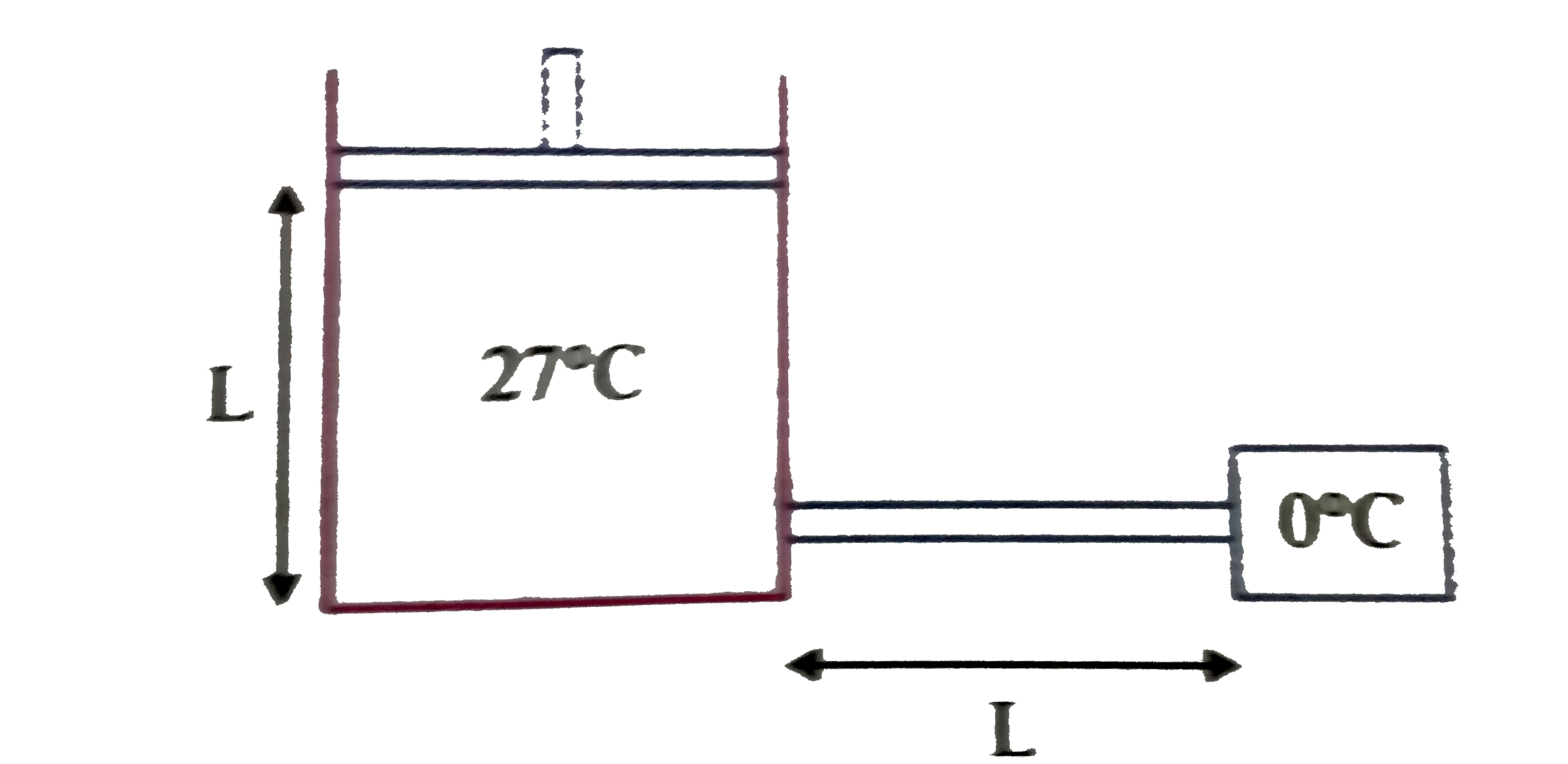 .
.
View SolutionTwo spheres of different materials one with double the radius and one-fourth wall thickness of the other are filled with ice. If the time taken for complete melting of ice in the larger sphere is `25` minutes and for smaller one is `16` minutes, the ratio of thermal conductivities of the materials of larger sphere to that of smaller sphere is:
View SolutionA calorimeter of negligible heat capacity contains `100cc` of water at `40^(@)C` . The water cools to `35^(@)C` in `5` minutes. The water is now replaced by k-oil of equal volume at `40^(@)C` . Find the time taken for the temperature to become `35^(@)C` under similar conditions. Specific heat capacities of water and K-oil are `4200Jkg^(-1)K^(-1)` and `2100Jkg^(-1)K^(-1)` respectively. Density of K-oil `=800kgm^(-3)` .
View SolutionThe two ends of a metal rod are maintained at temperatures `100^(@)C` and `110^(@)C` . The rate of heat flow in the rod is found to be `4.0 j//s`. If the ends are maintaind at temperatures `200^(@)C` and `210^(@)C`, the rate of heat flow will be :
View SolutionThree discs, A, B and C having radii 2m, 4m and6m respectively are coated with carbon black on their outer surfaces. The wavelengths corresponding to maximum intensity are `300nm, 400nm` and `500 nm`, respectively. The power radiated by them are `Q_A, Q_B and Q_C` respectively
(a) `Q_A` is maximum (b) `Q_B` is maximum (c) `Q_C` is maximum (d) `Q_A = Q_B = Q_C`
View SolutionIn which of the following process, convection does not take place primarily
View SolutionVariation of radiant energy emitted by sun, filament of tungsten lamp and welding arc as a function of its wavelength is shown in figure. Which of the following option is the correct match?
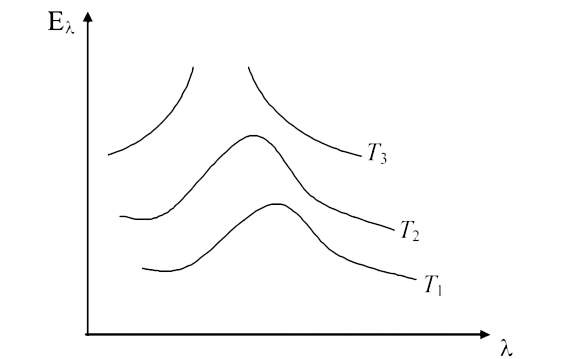
View SolutionA solid copper sphere (density rho and specific heat c) of radius r at an initial temperature `200K` is suspended inside a chamber whose walls are at almost `0K.` The time required for the temperature of the sphere to drop to 100K is …….
View SolutionThree rods `AB, BC` and `BD` of same length l and cross-sectionsl area `A` are arranged as shown . The end `D` is immersed in ice whose mass is `440 gm` Heat is being supplied at constant rate of `200cal//sec` from the end Time in which whole ice will melt (Latent heat of fusion of ice is `80cal//gm`
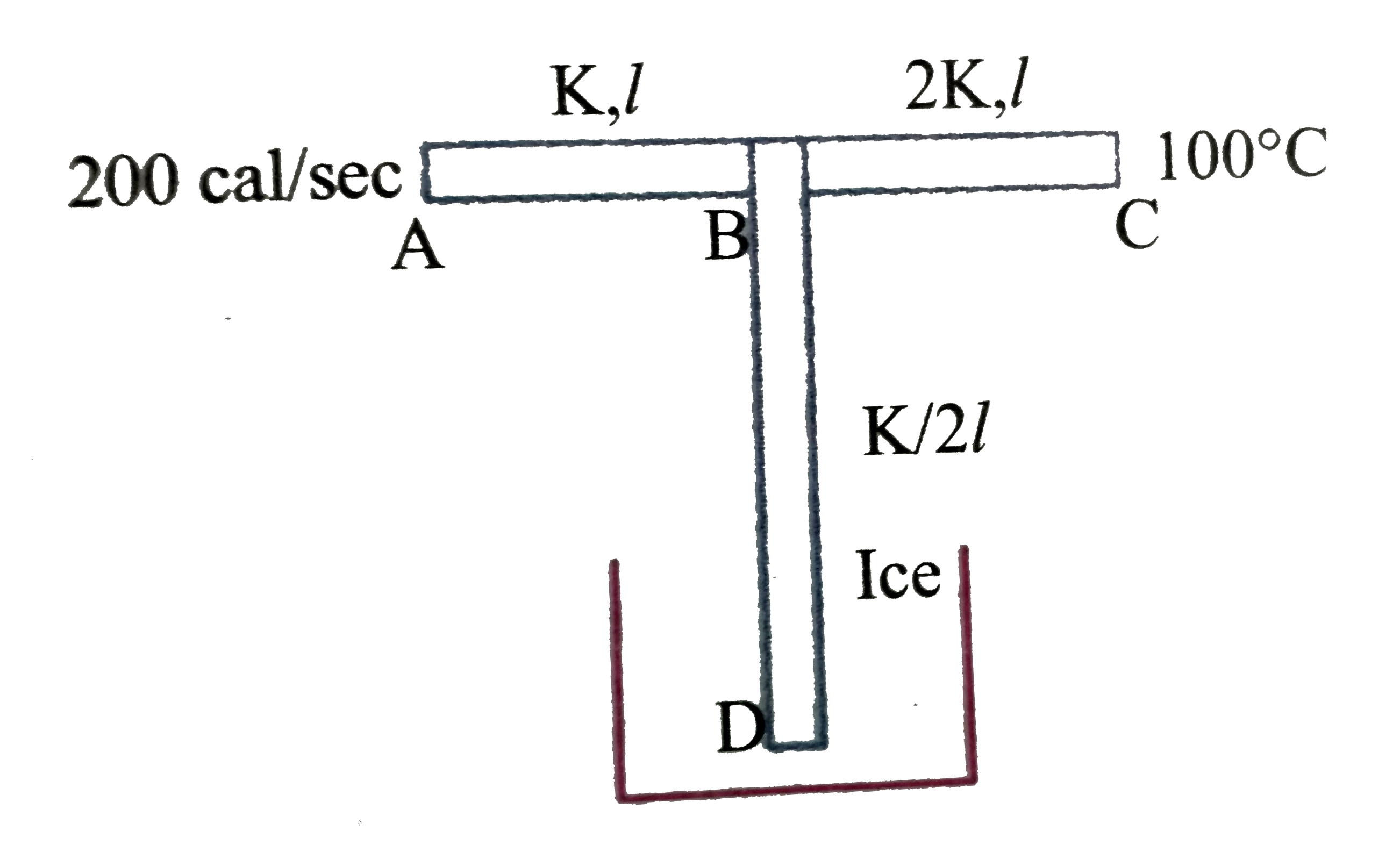 .
.
View Solution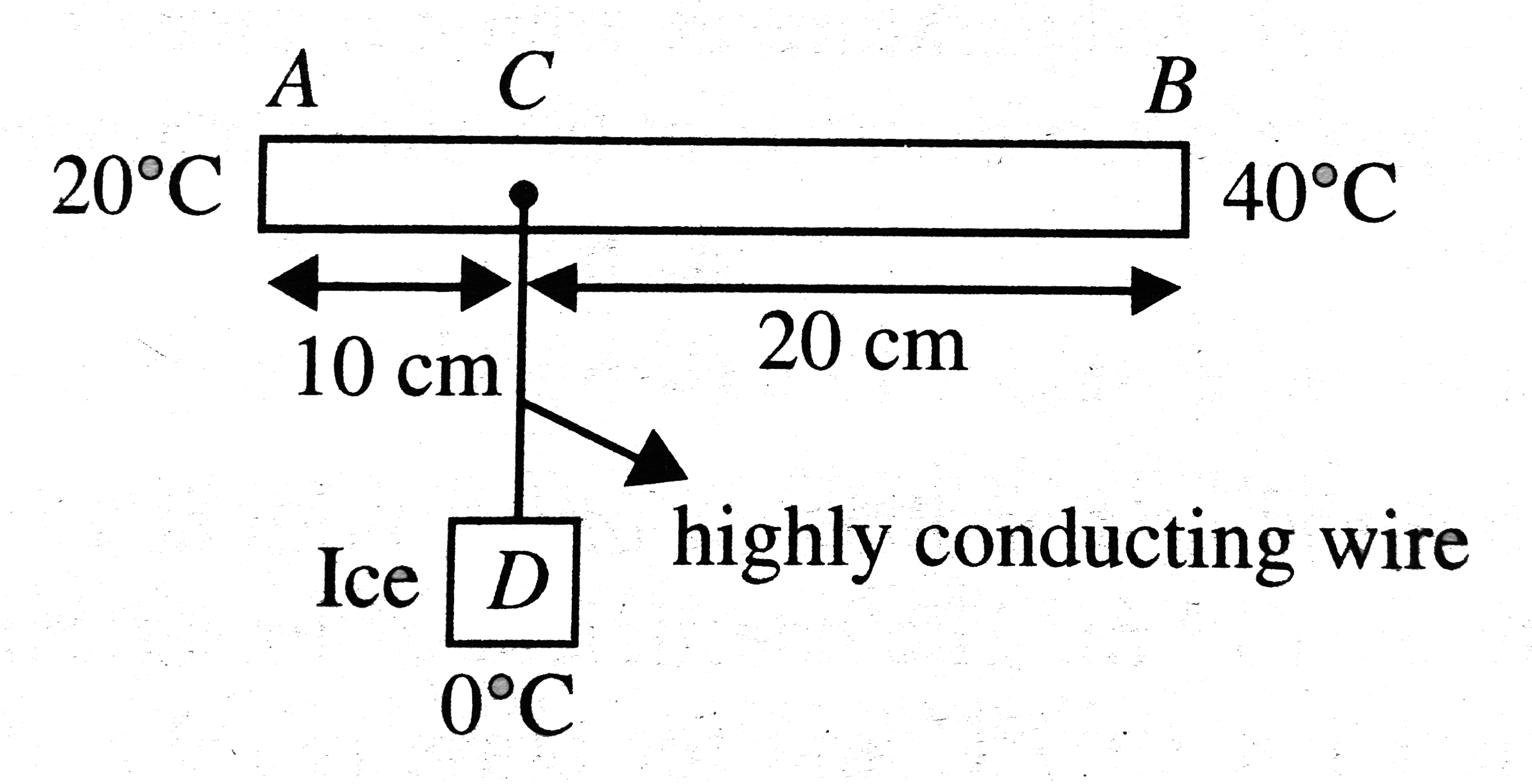
As shown in Fig. AB is rod of length 30 cm and area of cross section 1.0`cm^2` and thermal conductivity 336 SI units. The ends A and B are maintained at temperatures `20^@C` and `40^@C`, respectively .A point C of this rod is connected to a box D, containing ice at `0^@C` through a highly conducting wire of negligible heat capacity. The rate at which ice melts in the box is (assume latent heat of fusion for ice `L_f=80 cal//g`)
View SolutionWhich of the following graphs shows the correct variation in intensity of heat radiations by black body and frequency at a fixed temperature
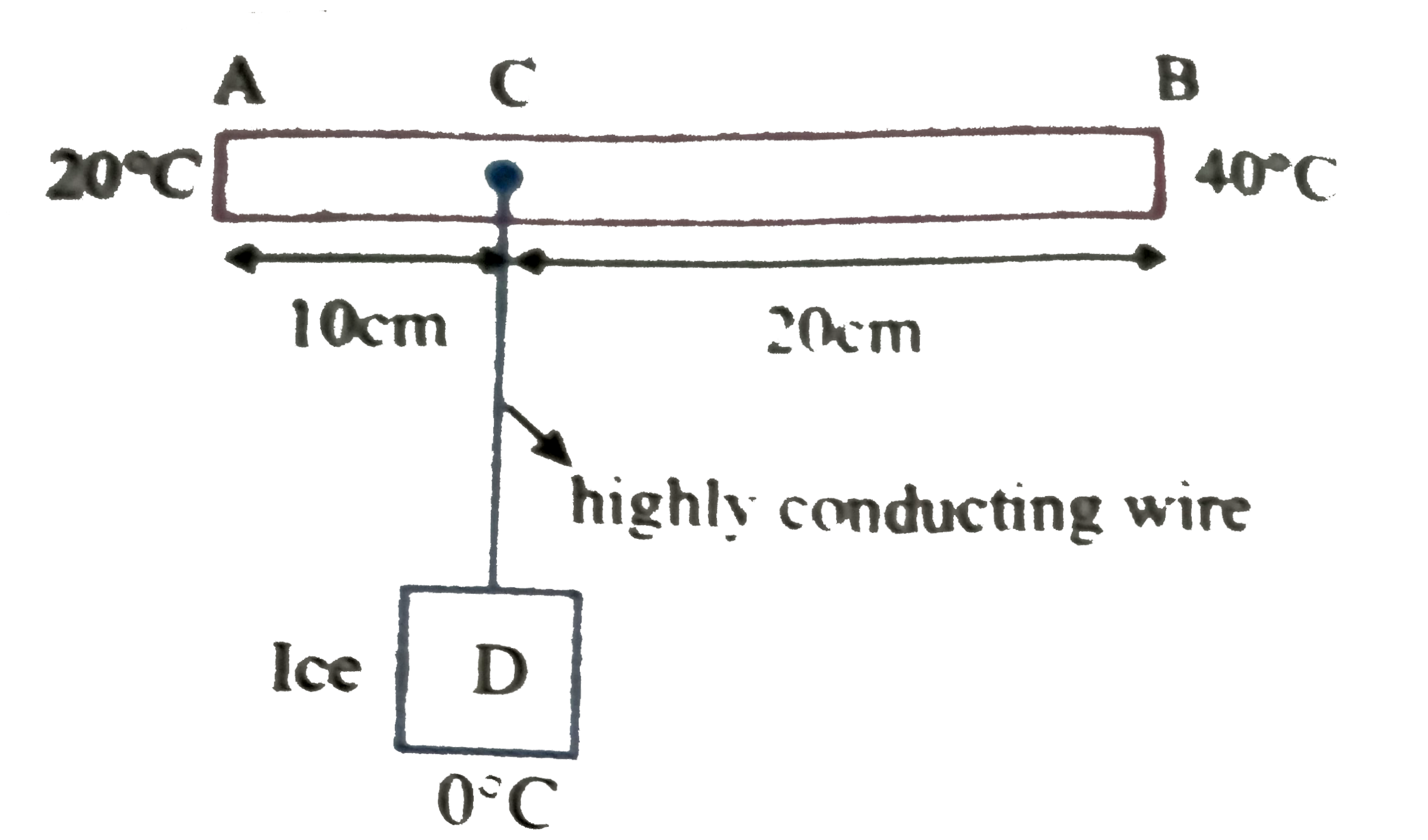 .
.
View SolutionThree different arrangemnets of matrials `1` and `2,3` to from a wall Thremal conductivities are `k_(1) gt k_(2) gt k_(3)` The left side of the wall is `20^(@)C` higher than the right side Temperature difference `DeltaT` across the material 1 has following relation in three cases
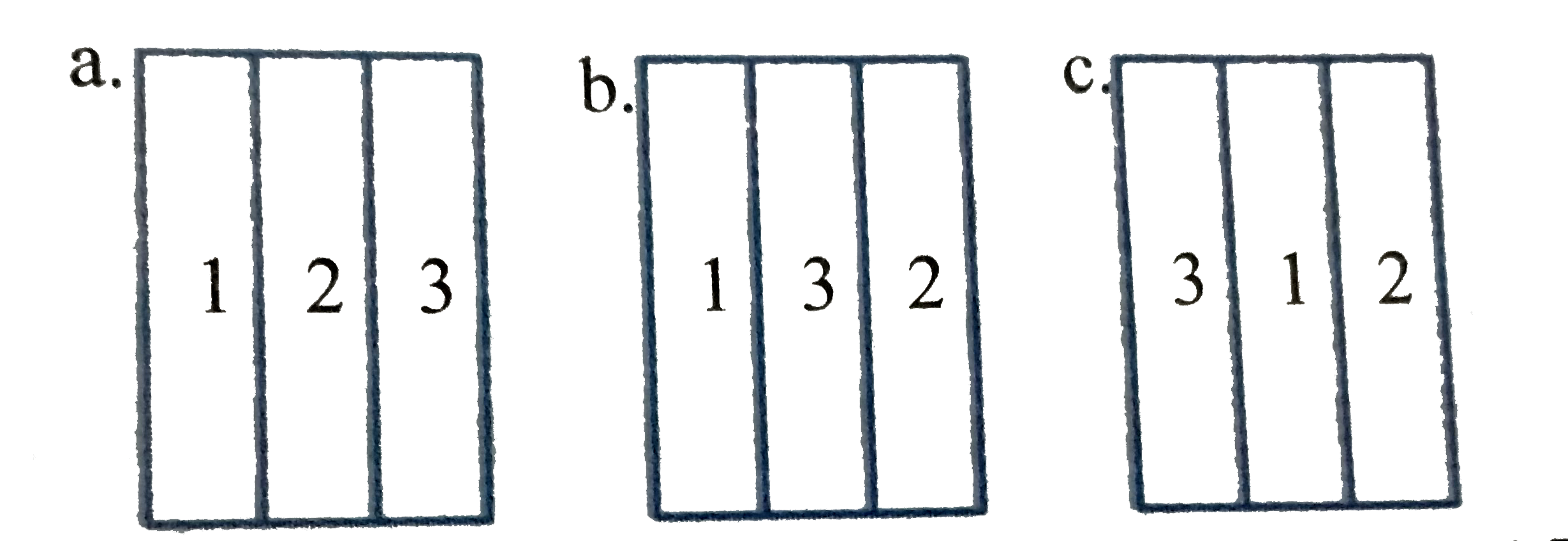
View SolutionThe figure shows a system of two concentric spheres of radii `r_1 and r_2` are kept at temperature `T_1 and T_2`, respectively. The radial rate of flow of heat in a substance between the two concentric spheres is proportional to
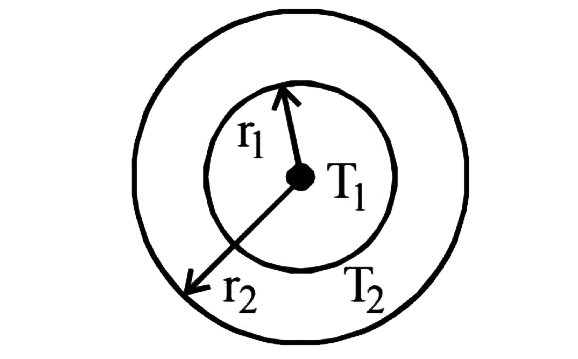
View SolutionTwo identical objects A and B are at temperatures `T_A` and `T_B`. Respectively. Both objects are placed in a room with perfectly absorbing walls maintained at a temperature `T(T_AgtTgtT_B)`. The objects A and B attain the temperature T eventually. Select the correct statements from the following:
View SolutionTwo solid spheres are heated to the same temperature allowed to cool under identical conditions Compare (i) initial rates of fall of temperatre, and (ii) initial rates of loss of heat Assume that all the surfaces have the same emissivity and ratios of their radii specific heats and densities are respectively `1: alpha 1: beta, 1 : gamma` .
View SolutionTwo bodies A and B have thermal emissivities of 0.01 and 0.81 respectively. The outer surface areas of the two bodies are same. The two bodies emit total radiant power at the same rate. The wavelength `lambda_B` corresponding to maximum spectral radiancy from B is shifted from the wavelength corresponding to maximum spectral radiancy in the radiation from A by 1.0 `mum`. If the temperature of A is 5802 K, calculate (a) the temperature of B, (b) wavelength `lambda_B`.
View SolutionA `100 cm` long cylindrical flask with inner and outer diameter `2 cm` and `4cm` respectively is completely filled with ice as shown in the The constant temperature outside the flask is `40^(@)C`
(Thermal conductivity of the flask is `0.693 W// m^(@)C, L_(ice) = 80cal// gm & In 2=0.693)`
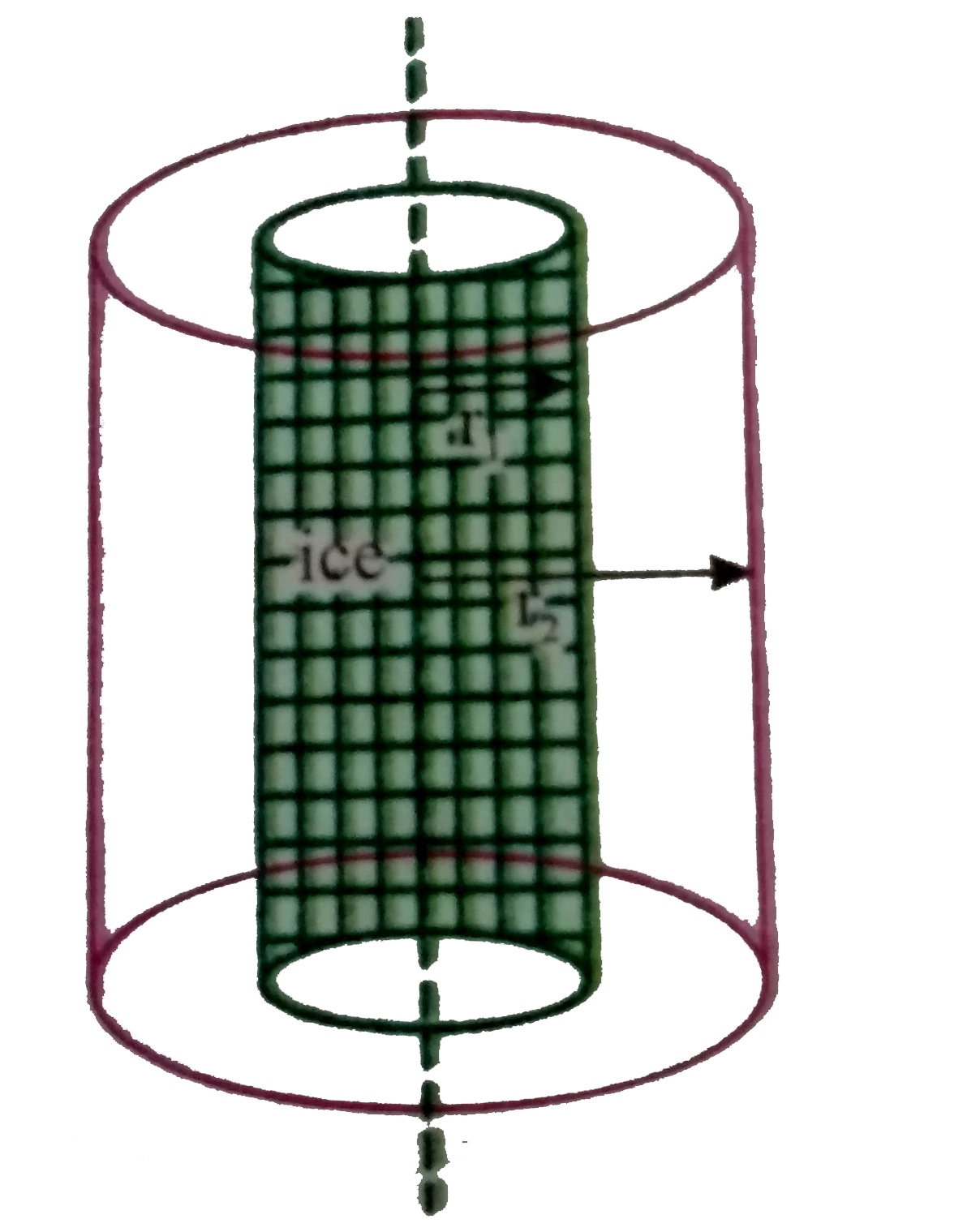
View SolutionA metal cylinder of mass `0.5kg` is heated electrically by a `12 W` heater in a room at `15^(@)C` The cylinder temperature rises nuniformly to `25^(@)C` in 5 min and finally becomes constant at `45^(@)C` Asuming that the rate of heat loss is proporational to the excess temperature over the surroundings .
View SolutionWhen we consider convection with radiation in Newton's law of cooling while temperature of the object in consideration is sightly higher than the environment temperature Choose correct statements about rate of heat loss .
View SolutionAn incandesent bulb has a thin filament of tungsten that is heated to high temperature by passing an electric current The hot filament emits black-body radiation The filament is observed to break up at random locations after a sufficiently long time of operation due to non-uniform evapo ration of operation due to non-uniform evapo ration of ungsten from the filament If the buld is powered at constant voltage which of the following statement (s) is (are) ture ? .
View SolutionA spherical black body of radius r radiated power `P` at temperature T when placed in surroundings at temprature `T_(0) (lt ltT)` If `R` is the rate of colling .
View SolutionThe total energy of a blackbody radiation source is collected for one minute and used to heat water The temperature of the water in creases from `20^(@)C` to `20.5^(@)C` If the absolute temperature of the blackbody is diubled and the experiment repeated which of the following statements would be most nearly `COR-RECT` ? .
View SolutionA body is kept inside a container the temperature of the body is `T_(1)` and the temperature of the container is `T_(2)` the rate at which body absorbs the energy is `alpha` The emissivity of the body is The radiation striking the body is either absorbed or reflected
Ater a long time the temperature of the body will be .
View SolutionA body is kept inside a container the temperature of the body is `T_(1)` and the temperature of the container is `T_(2)` the rate at which body absorbs the energy is `alpha` The emissivity of the body is The radiation striking the body is either absorbed or reflected
At what rate of body will absorb the radiant energy .
View SolutionA body is kept inside a container the temperature of the body is `T_(1)` and the temperature of the container is `T_(2)` the rate at which body absorbs the energy is `alpha` The emissivity of the body is The radiation striking the body is either absorbed or reflected
At what rate of body will basorb the radiant energy .
View SolutionTwo rods `A` and `B` of same cross sectional are `A` and length l connected in series between a source
`(T_(1) =100^(@)C)` and a sink `(T_(2) =0^(@)C)` as shown in The rod is laterally insulated
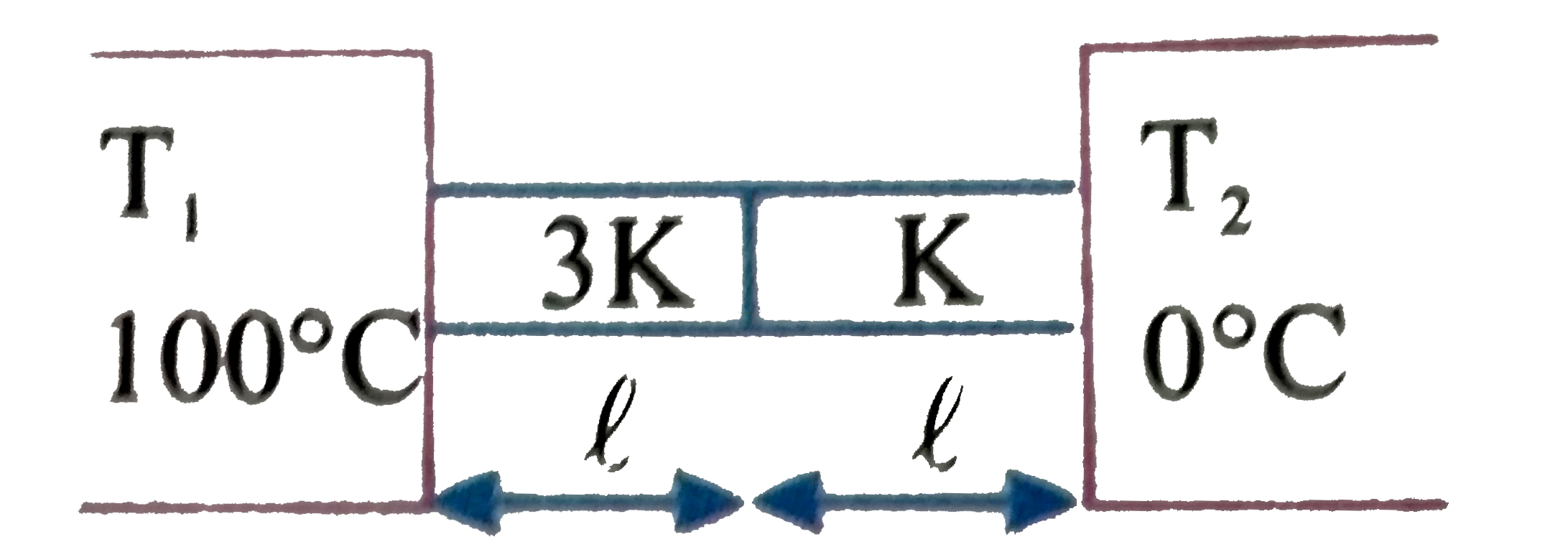
The ratio of thermal resistance of the rod is .
View SolutionTwo rods `A` and `B` of same cross sectional are `A` and length l connected in series between a source
`(T_(1) =100^(@)C)` and a sink `(T_(2) =0^(@)C)` as shown in The rod is laterally insulated
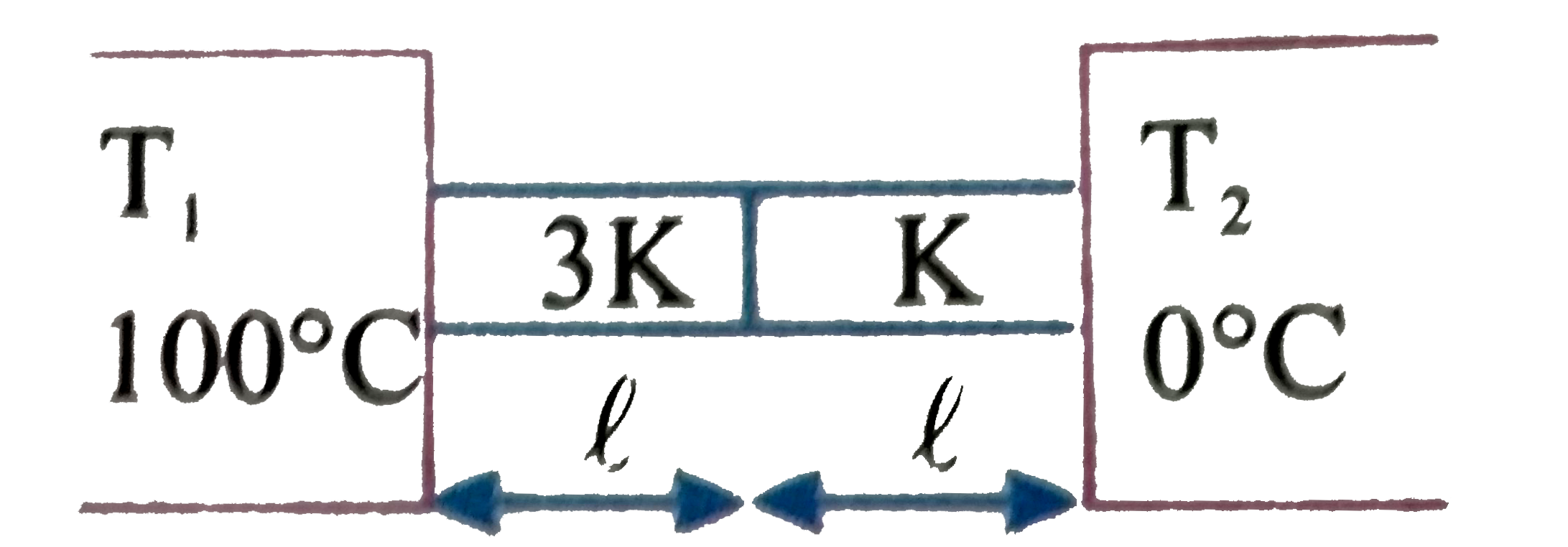
If `A_(A)` and `T_(B)` are the temperature drops across temperature gradients the rod `A` and `B` then .
View SolutionThe shows a radiant energy spectrum graph for a black body at at temperature `T`
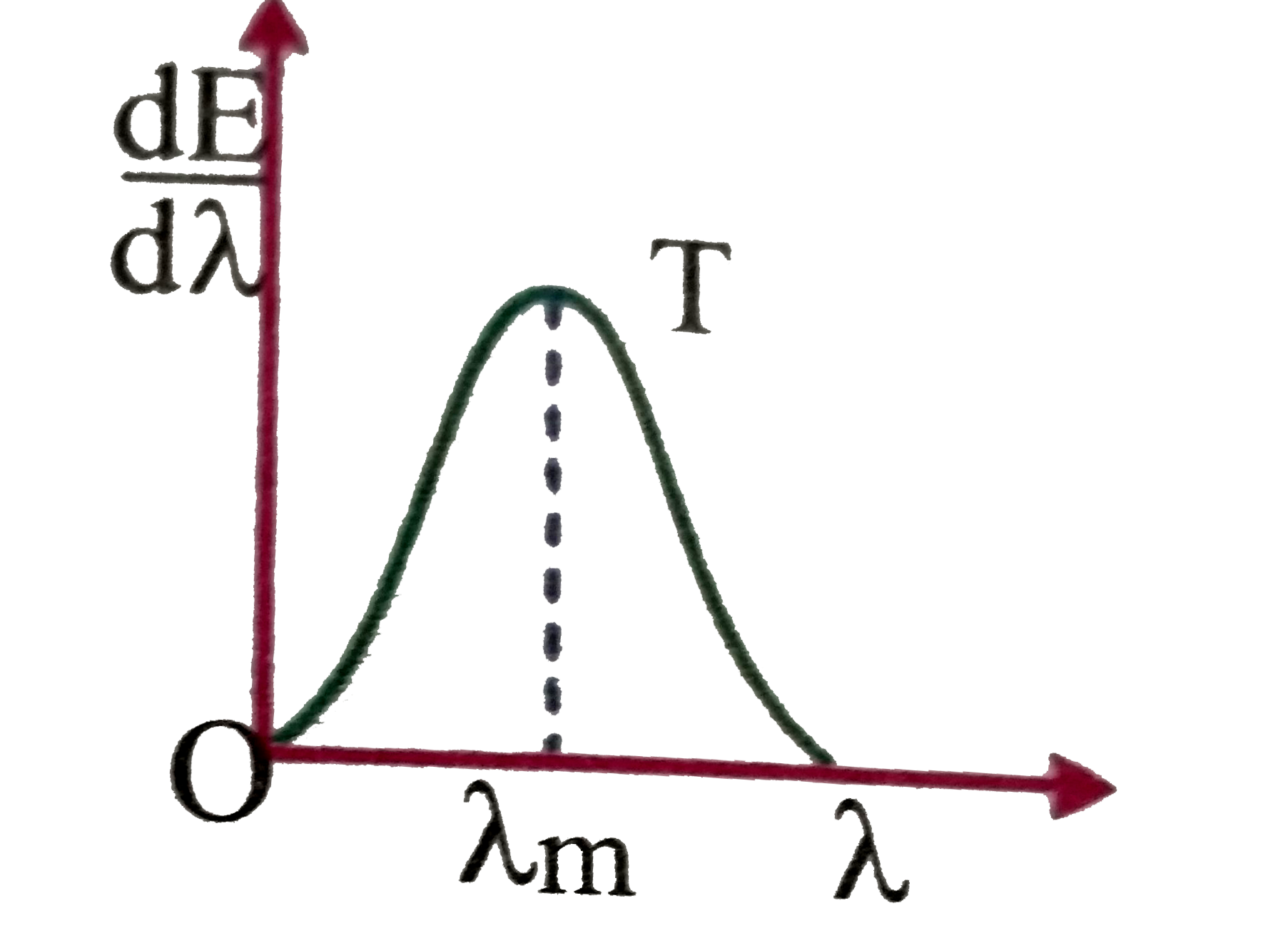
Choose the correct statements (s) .
View SolutionThe shows a radiant energy spectrum graph for a black body at at temperature `T`
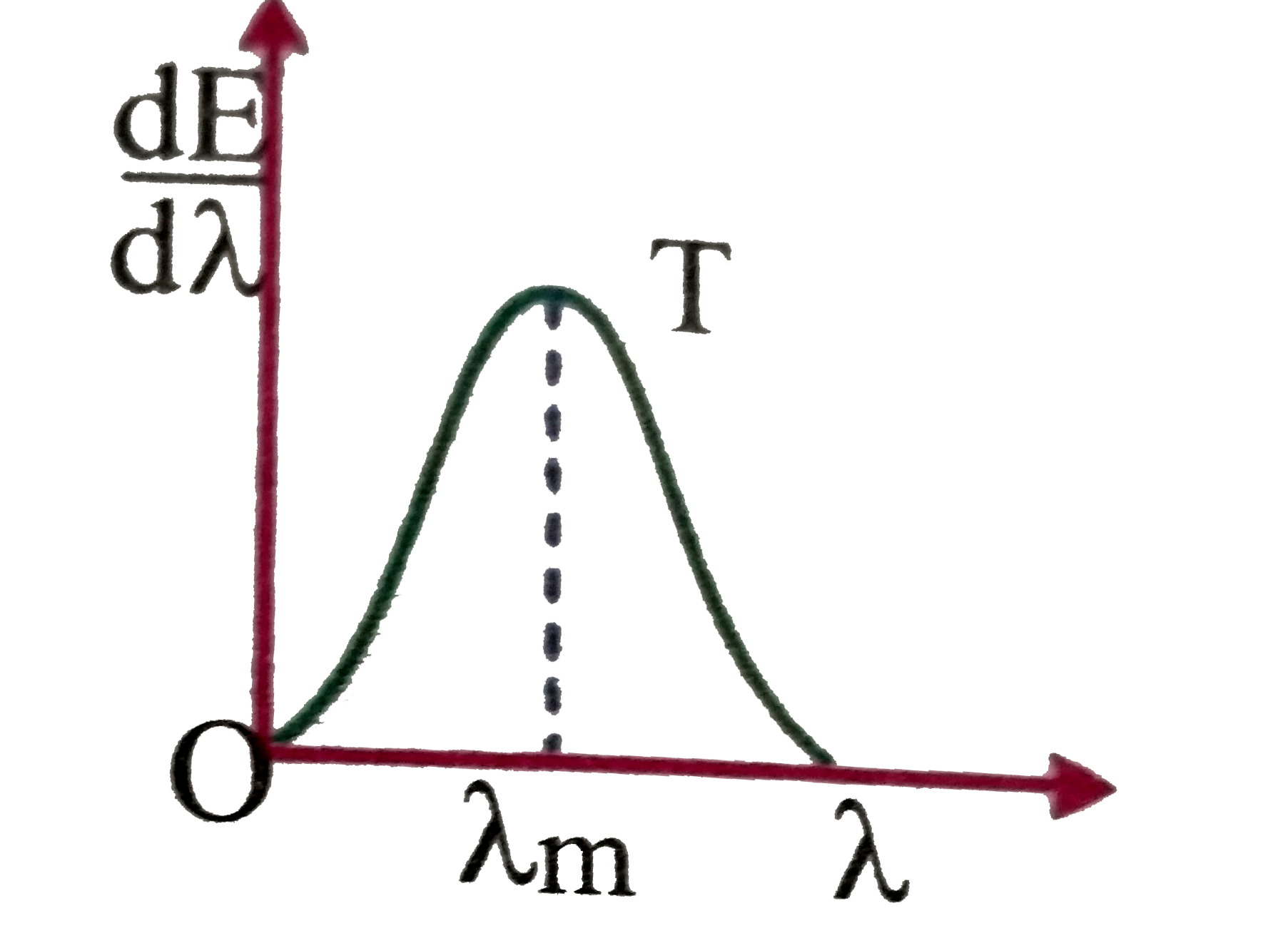
If the temperature of the body is raised to a higher temperature `T` then choose the correct statement (s).
View SolutionA rod of length l with thermally insulated lateral surface is made of a matrical whose thermal conductivity varies as `K =C//T` where `C` is a constant The ends are kept at temperature `T_(1)` and `T_(2)` The temperature at a distance x from the first end where the temperature is `T_(1), T =T_(1)((T_(2))/(T_(1)))^(nx//2l)` Find the value of n? .
View SolutionA solid copper shere of density `rho` specific heat c and radius r is at temperature `T_(1)` It is suspended inside a chamber whose walls are at temperature 0 `K` The time required for the temperature of sphere to drop to `T_(2)` is `(rrhoc)/(xesigma)((1)/(T_(2)^(3))-(1)/(T_(1)^(3)))` Find the value of x? Take the emmissivity of teh sphere to be equal to e .
View SolutionTwo identical rods are connected between two containers. One of them is at `100^(@)C` containing water and another is at `0^(@)C` containing ice. If rods are connected in parallel then the rate of melting of ice is `q_(1)g//s` . If they are connected in series then teh rate is `q_(2)g//s` . The ratio `q_(2)//q_(1)` is
View SolutionTwo spherical bodies A (radius 6cm) and B (radius 18cm) are at temperature `T_(1)` and `T_(2)` respectively The maximum intensity in the emission spectrum of A is at `500 nm` and in that of `B` is at `1500nm` considering them to be black bodies, what will be the ratio of total energy radiated by `A` to that of `B` .
View SolutionA body cools in a surrounding which is at a constant temperature of `theta_(0)` Assume that it obeys Newton's law of cooling Its temperature `theta` is plotted against time t Tangents are drawn to the curve at the points `P (theta =theta_(1))` and `Q(theta =theta_(2))` These tangents meet the time axis at angle of `phi_(2)` and`phi_(1)` as shown
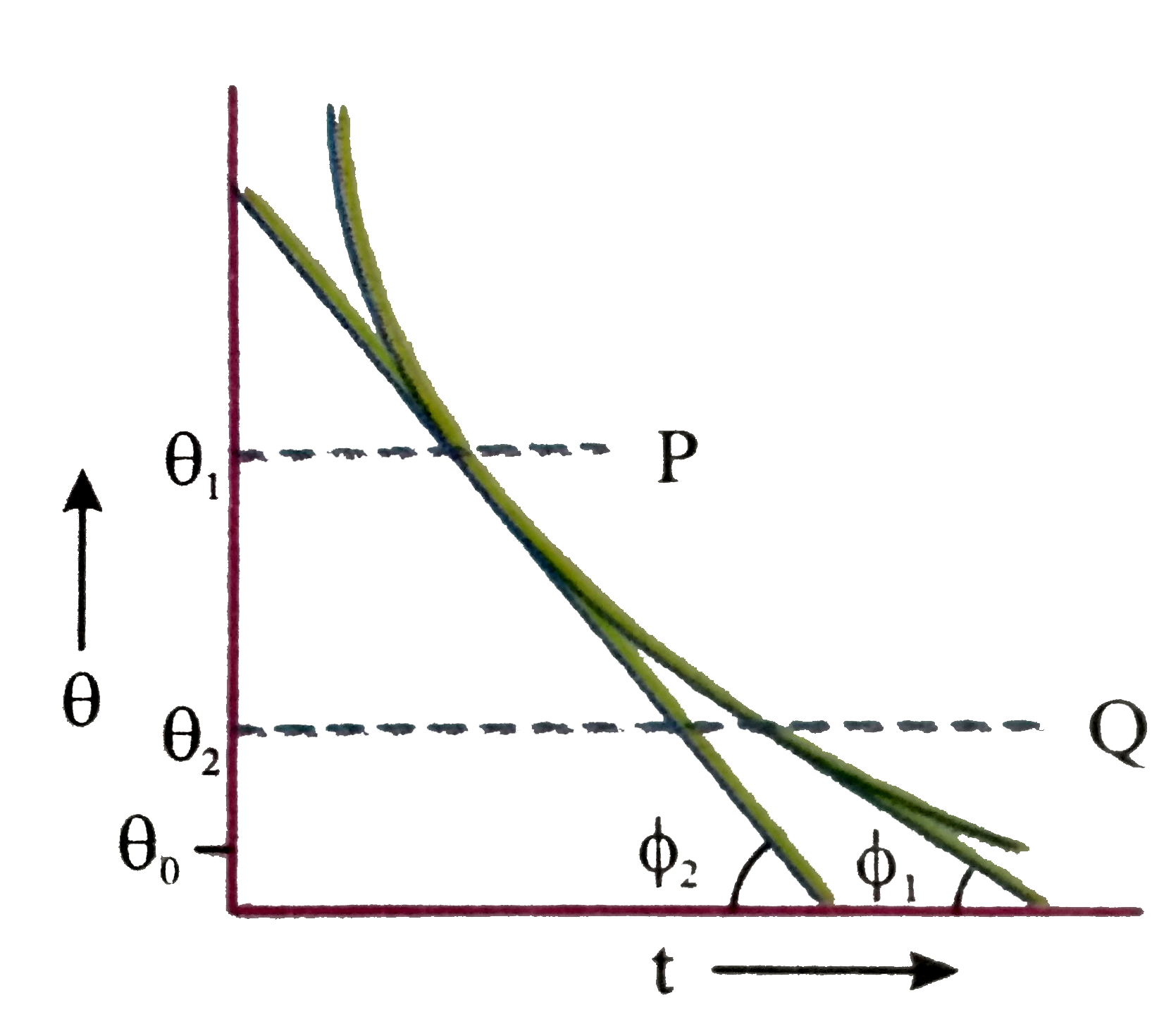 .
.
View SolutionA body with an initial temperature `theta_(1)` is allowed to cool in a surrounding which is at a constant temperature of `theta_(0) (theta lt theta_(1))` Assume that Newton's law of cooling is obeyed Let `k =` constant The temperature of the body after time t is best experssed by .
View SolutionThe intensity of radiation emitted by the sun has its maximum value at a wavelenght of `510 nm` and that emitted by the north star has the maximum value at `350 nm` If these stars behave like balackbodies the nthe ratio of the surface temperature of the sun and the north star is .
View SolutionA rod of unifrom cross section is heated at temperature `t_(0)` at a point which is at `n_(1)` times if its length `(n_(1) lt 1)` from its one end in stready state The temperature at this end is `t_(1)` and at other end is `t_(2)` Rate of vapourisation of water at either end of the rod is same. The end at which temperature is `t_(2)` is how much more far away that the other end from the point at which the rod is heated .
View SolutionA body obeying Newton's law of cooling cools in a surrounding which is at a constant temperature Its temperature `theta` is plotted against time There are two points on the curve with temperatures `theta_(2)` and `theta_(1)(theta_(2) gttheta_(1))` such that tangents on these points make angles of `2phi` and half of its with time axis respectively Find the temperature of the surrounding .
View SolutionThe three rods of same meterial and crosssectional area from the sides of a triangle `ABC` The points `A,B` and `C` are maintained at temperature `T T sqrt2` and `(3T)/((sqrt2 +1))` respectively Assuming that only heat conducting takes place the system is in steady state, find the angle at `B` The temperature difference per unit length along `SB` and `CA` is equal
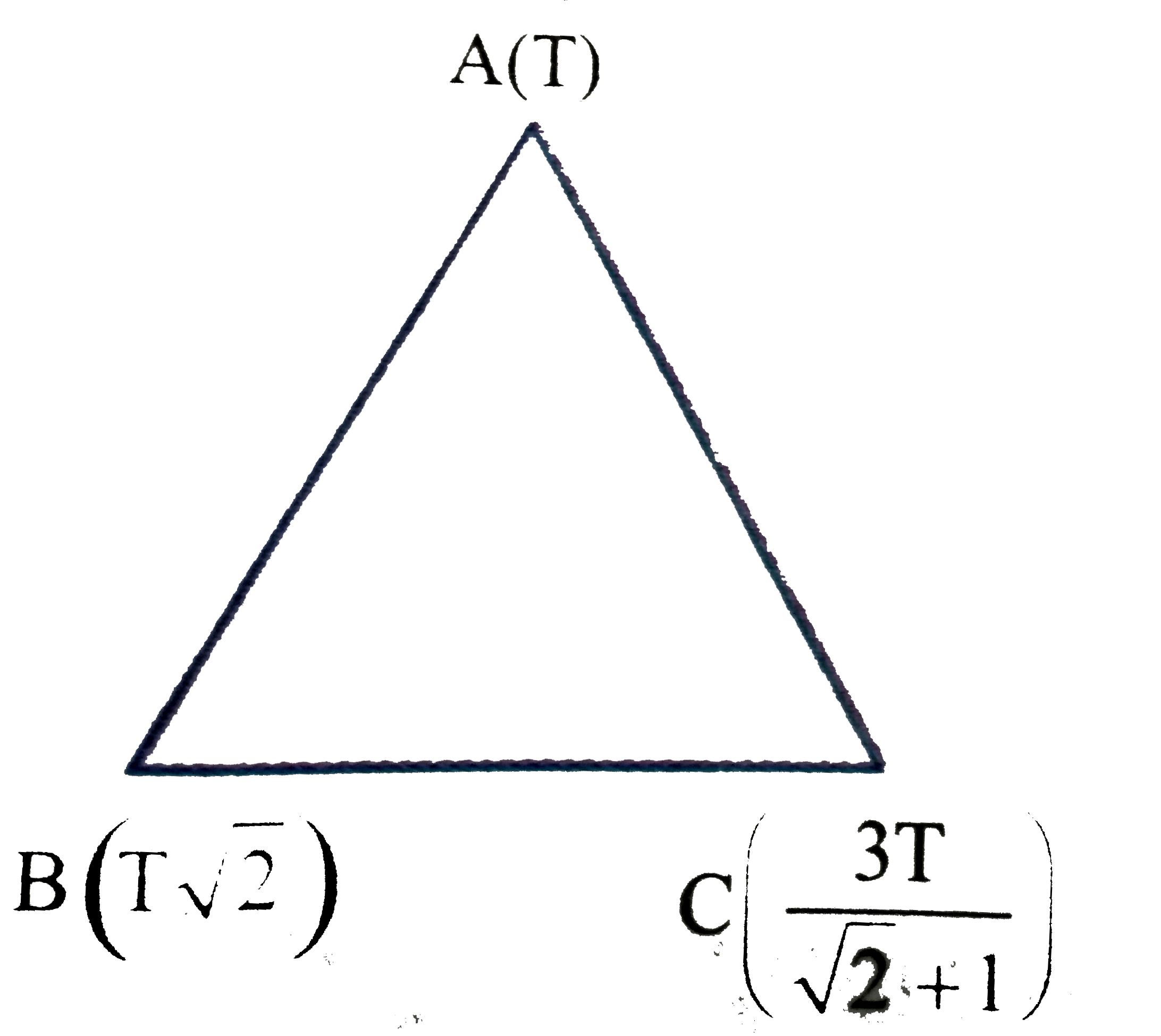 .
.
View SolutionThemperature of a body `theta` is slightly more than the temperature of the surrounding `theta_(0)` its rate of cooling `(R )` versus temperature of body `(theta)` is plotted its shape would be .
View SolutionA body cools from `80^(@)C` to `70^(@)C` in 10 minutes Find the required further fir it to cool from `70^(@)C` to `60^(@)C` Assume the temperature of the surrounding to be `30^(@)C` .
View SolutionThe emissive power of a black body at `T=300K` is `100Watt//m^(2)` consider a body B of area `A=10m^(2)` coefficient of reflectivity `r=0.3` and coefficient of transmission `t=0.5` its temperature is 300 K. then which of the followin is correct:
View SolutionA spherical shell of inner radius `R_(1)` and outer radius `R_(2)` is having variable Where 'r' is the distance from the centre Two surface of the shell are maintained at temperature `T_(1)` respectively `(T_(1) ltT_(2))` The heat current flowing through the shell would be .
View SolutionA radiator whose temperature is `T^(@)C` is used to heat the room in the cold weater The radiator is able maintain a room temmperature of `30^(@)C` when ouside temperature is `10^(@)C` and `15^(@)C` when outside temperature is `30^(@)C` Determine the temperature of the radiator [Assume Newton's law of cooling to be valid] .
View SolutionThe Thin walled spheres of different matrials one with double the radius and one fourth wall thickness of the other are filled with ice if the time taken for complete metting of ice in the sphere of larger radius is `25 min` and that for smaller one is `6min` the ratio of the thermal condutivities of the matrials of larger sphere to the smaller sphere is .
View SolutionAn object is being heated by a heater supplying `60W` of heat. Temperature of surrounding is `20^(@)C` and the temperature of object becomes constant at `50^(@)C` Now the heater is switched off What is the rate at which the object will lose heat when its temperature has dropped to `30^(@)C` .
View SolutionThe container `A` is constantly maintained at `100^(@)C` and insulated container `B` in the contains ice at `0^(@)C` Different rods are used to connect them For a rod made of copper, it takes 30 mintes for the ice to melt and for a rod of steel of same cross-section taken in different experiment it takes 60 minutes for ice to melt. When these rods are simultaneously connected in parallel, the ice melts is
 .
.
View SolutionThe spectra of radiation emitted by two distant stars are shown below The ratio of the surface temperature of star `A` to that of star `B, T_(A) :T_(B)` is approximately
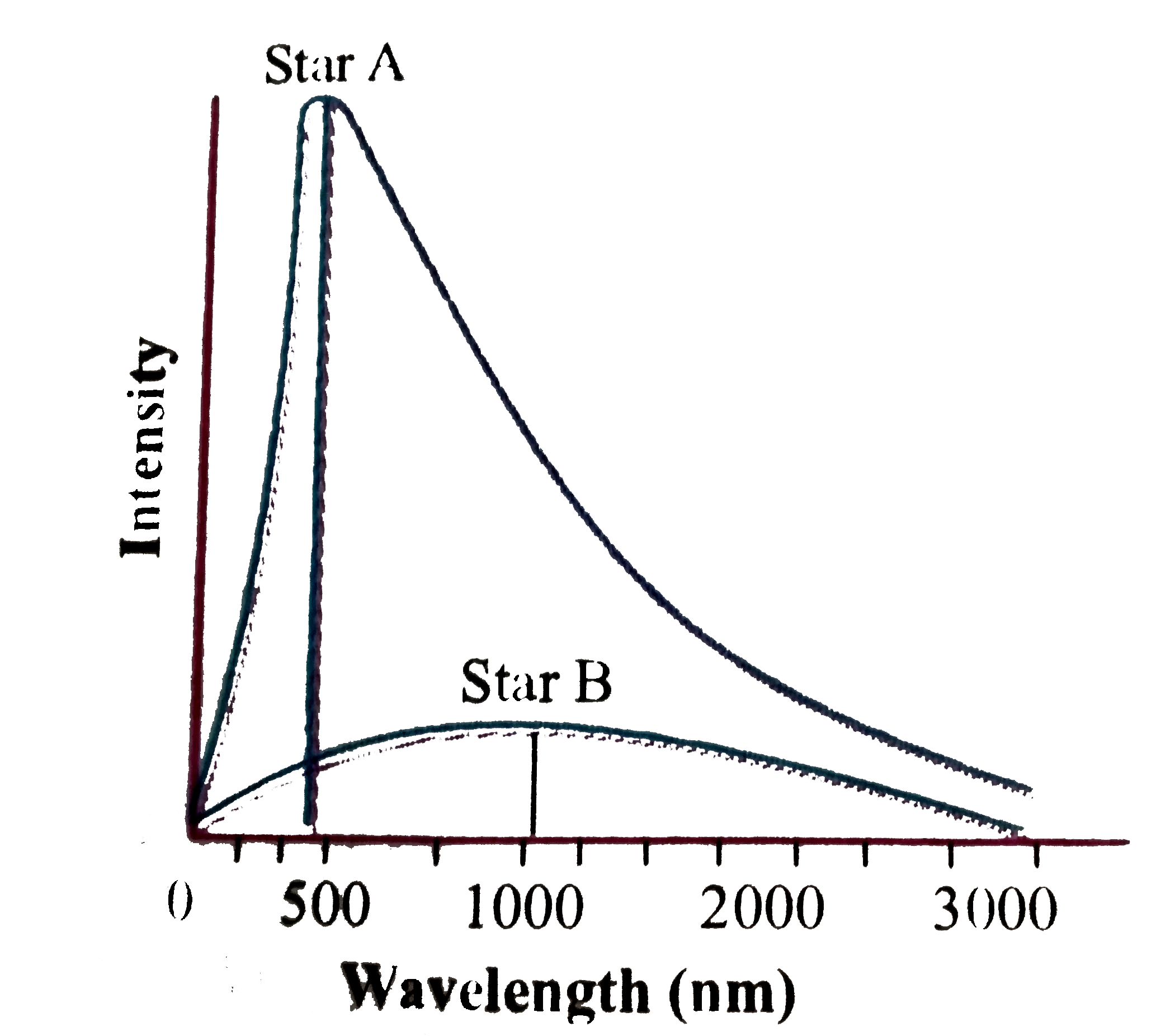 .
.
View SolutionAn irregular rod of same uniform material as shown in is conducting heat at a steady rate. The temperature gradient at varoius sections versus area of cross section graph will be
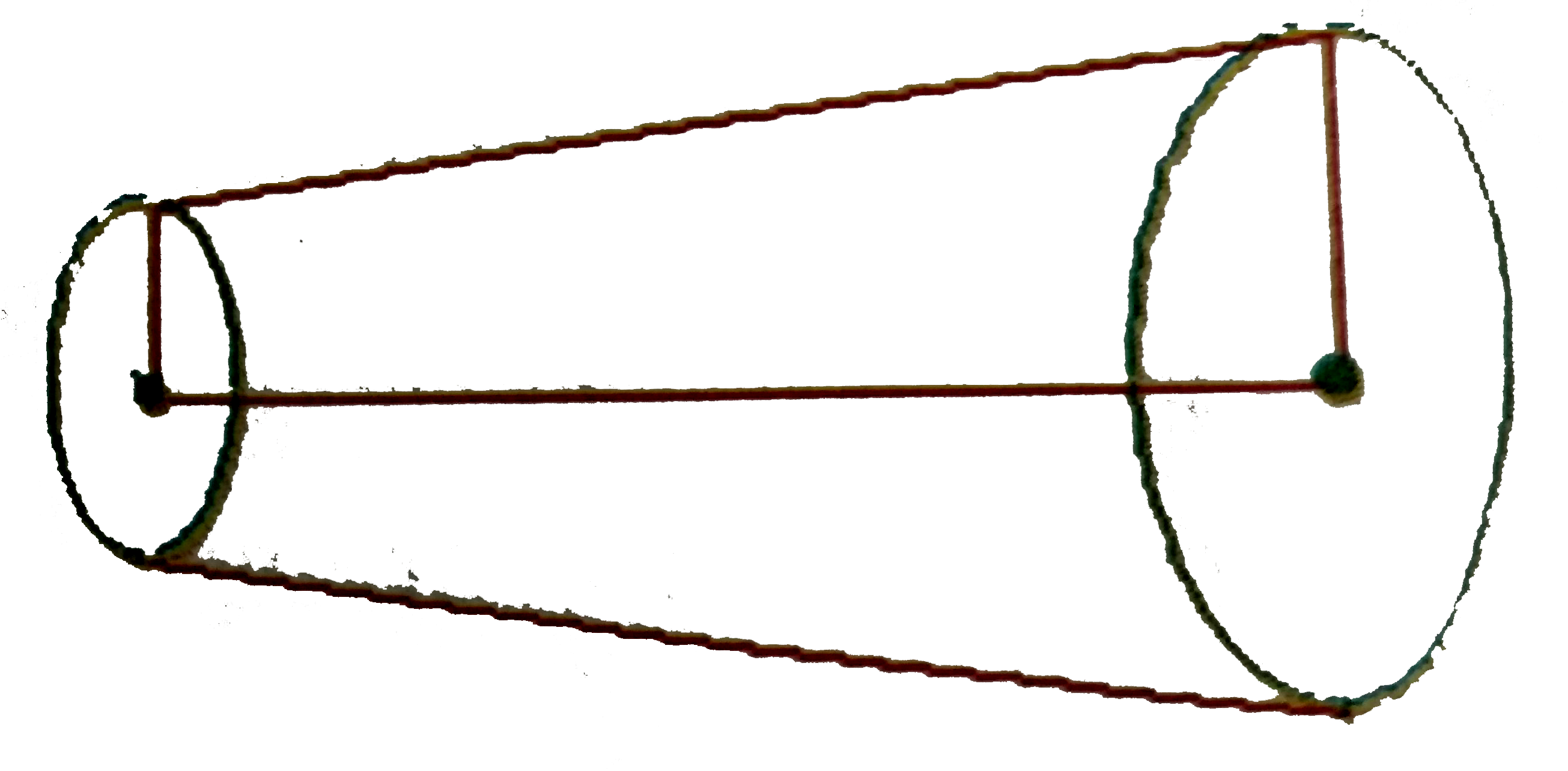 .
.
View SolutionA solid copper sphere of dimater `10mm` is cooled to temperature of `150K` and is then placed in an enclousure at `290K` Assuming that all interchange of heat is by radiation, calculate the initial rate of rise of temperature of the sphere The sphere may be treated as a black body `rho_(copper) =8.93xx 10^(3)kg//m^(3)`
`s = 3.7xx10^(2) Jkg^(-2) K^(-1) , sigma = 5.7 xx 10^(8) Wm^(-2) K^(-4)` .
View Solution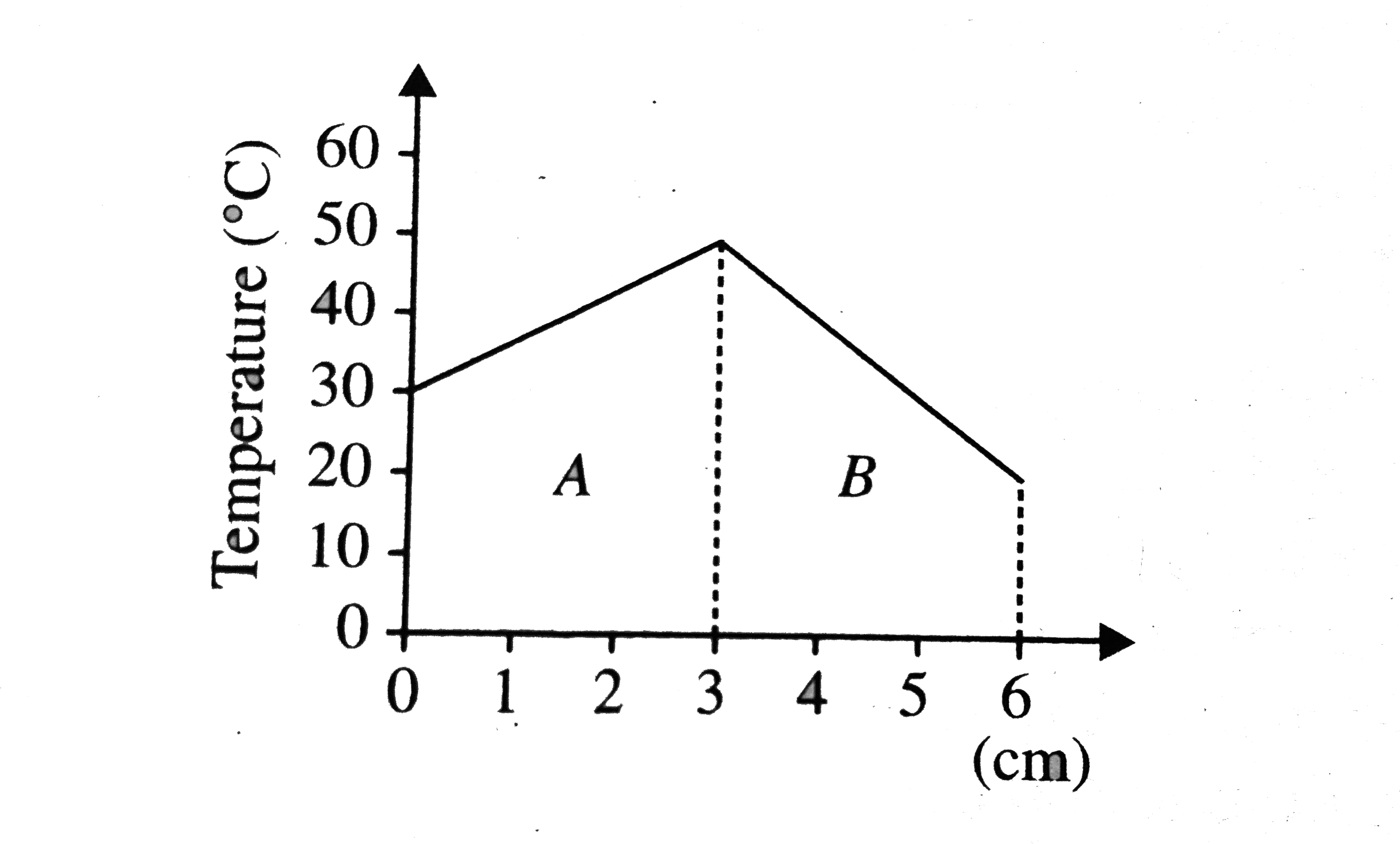
The temperature across two different slabs A and B are shown I the steady state (as shown Fig) The ratio of thermal conductivities of A and B is
View Solution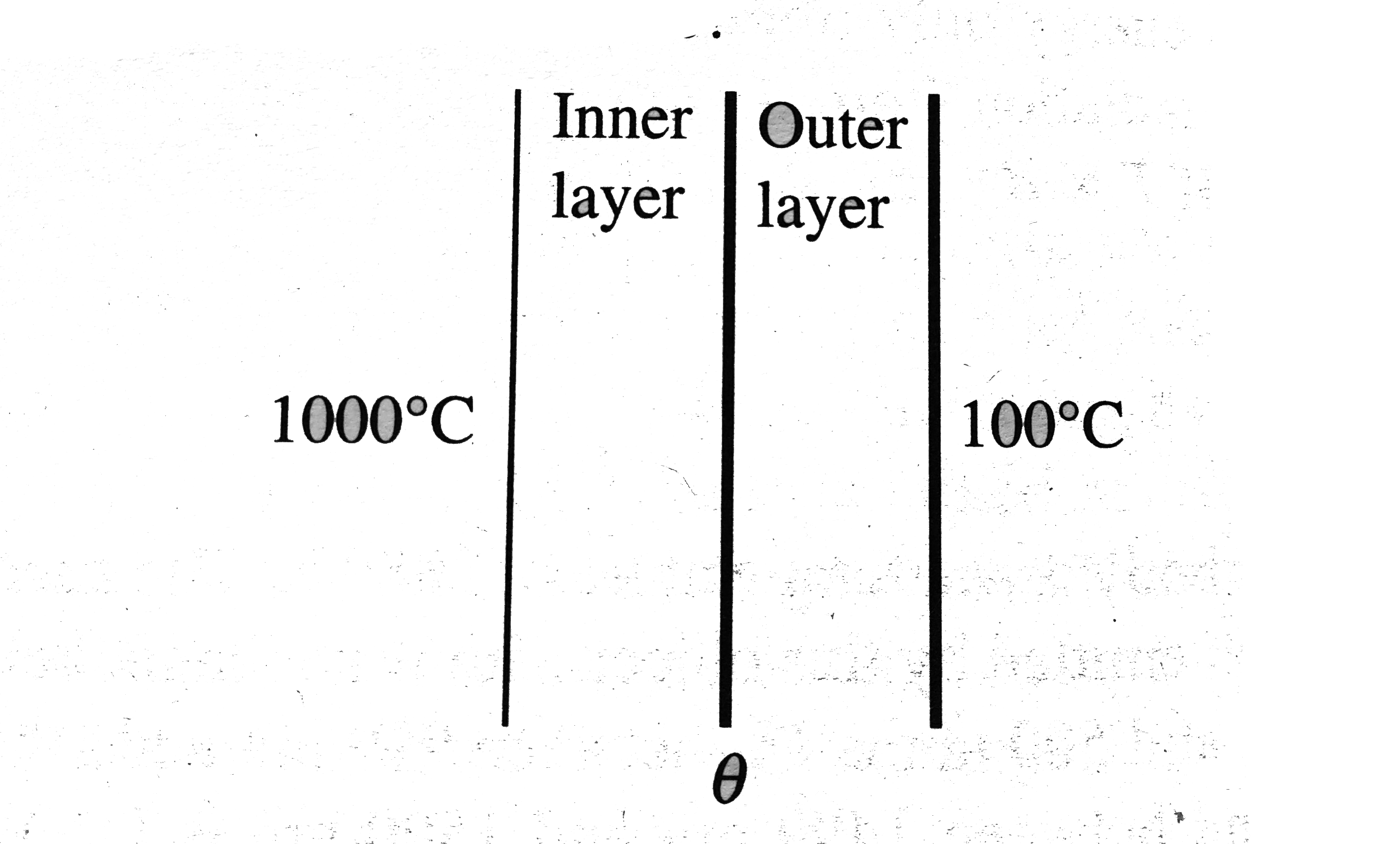
The temperature drop through a two layer furnace wall is `900^@C`. Each layer is of equal area of cross section. Which of the following actions will result in lowering the temperature `theta` of the interface?
View SolutionSeven identical rods of matrical of thermal conductivity k are connected as shown in All the rod are of identical length l and cross sectional area `A` if the one end `b` is kept at `100^(@)C` and the other end is kept at `0^(@)C` The temperatures of the junctions `C,D` and `E(theta_(D)andtheta_(E))` be in the steady state
 .
.
View SolutionA composite block is made of slabs A,B,C,D and E of different thermal conductivities (given in terms of a constant K and sizes (given in terms of length, L) as shown in the figure. All slabs are of same width. Heat 'Q' flows only from left to right through the blocks. Then in steady state
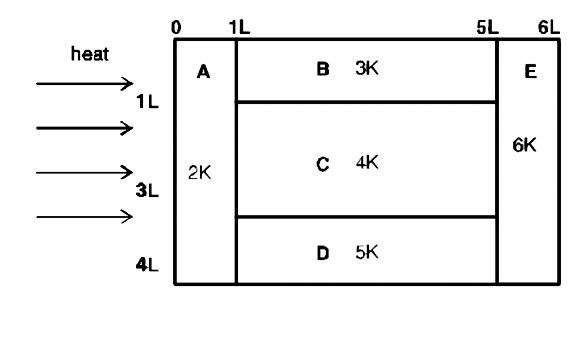
View SolutionIn Newton's law of cooling `(d theta)/(dt)=-k(theta-theta_(0))` the constant `k` is proportional to .
View SolutionConsider a spherical body `A` of radius `R` which is placed concentrically in a hollow enclosure `H` of radius `4R` as shown in the The temperature of the body `A` and `H` are `T_(A)` and `T_(H)` respectively Emissivity transmittivity and reflactivity of two bodies `A` and `H` are `(e_(a),e_(H)),?(t_(A),t_(H)),` and `(r_(A),r_(H))` respectively (Assume no absorption of the thermal energy by the space in between the body and enclosure as well as outside the enclousre and all radiations to be emitted and absorbed normal to the surface `[Tske sigma xx 4pi r^(2) xx 300^(4) = betaJ//s]`
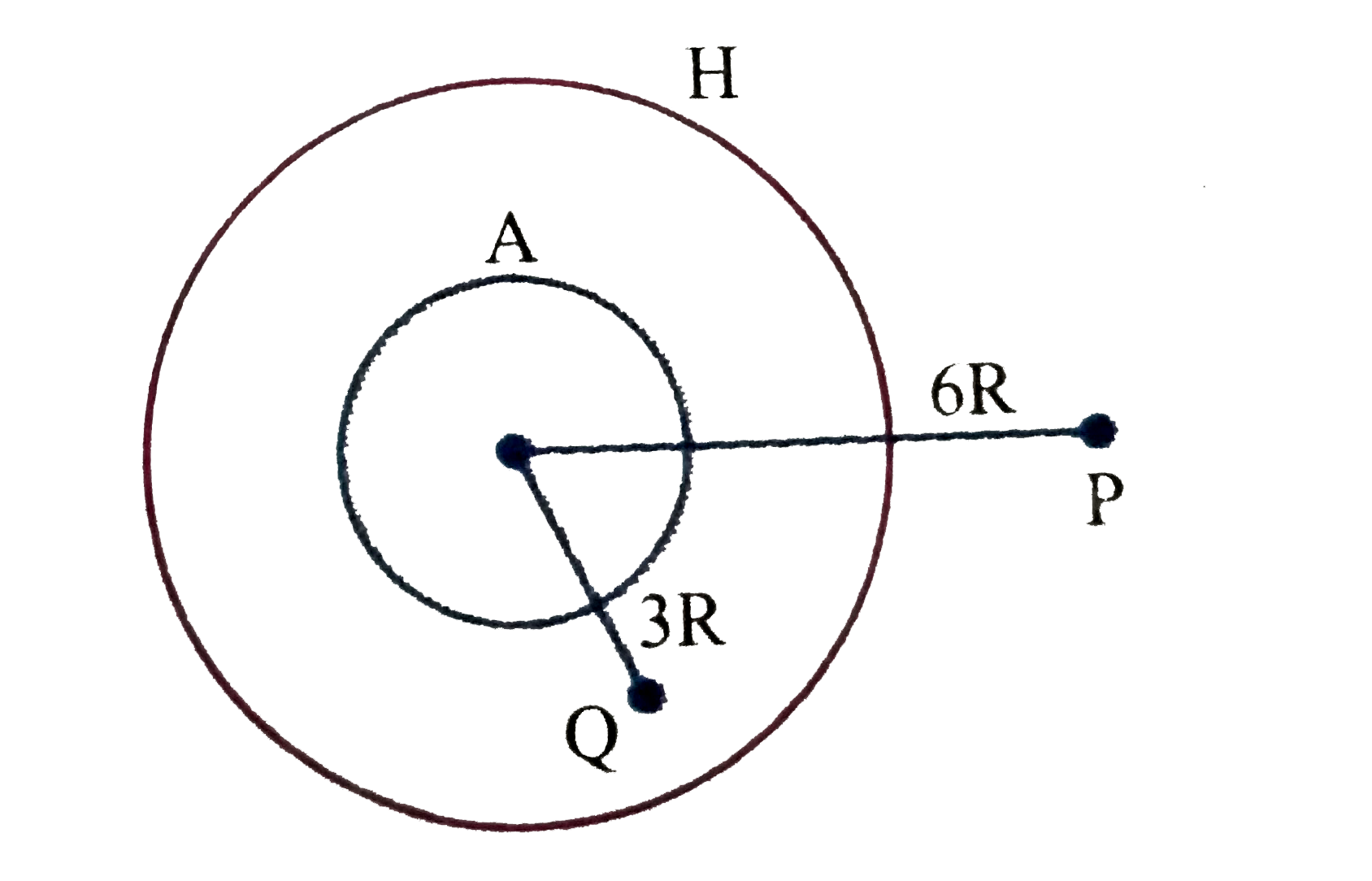
In above quations if body A has then mark out the correct statements (s) .
View SolutionConsider a spherical body `A` of radius `R` which is placed concentrically in a hollow enclosure `H` of radius `4R` as shown in the The temperature of the body `A` and `H` are `T_(A)` and `T_(H)` respectively Emissivity transmittivity and reflactivity of two bodies `A` and `H` are `(e_(a),e_(H)),?(t_(A),t_(H)),` and `(r_(A),r_(H))` respectively (Assume no absorption of the thermal energy by the space in between the body and enclosure as well as outside the enclousre and all radiations to be emitted and absorbed normal to the surface `[Tske sigma xx 4pi r^(2) xx 300^(4) = betaJ//s]`
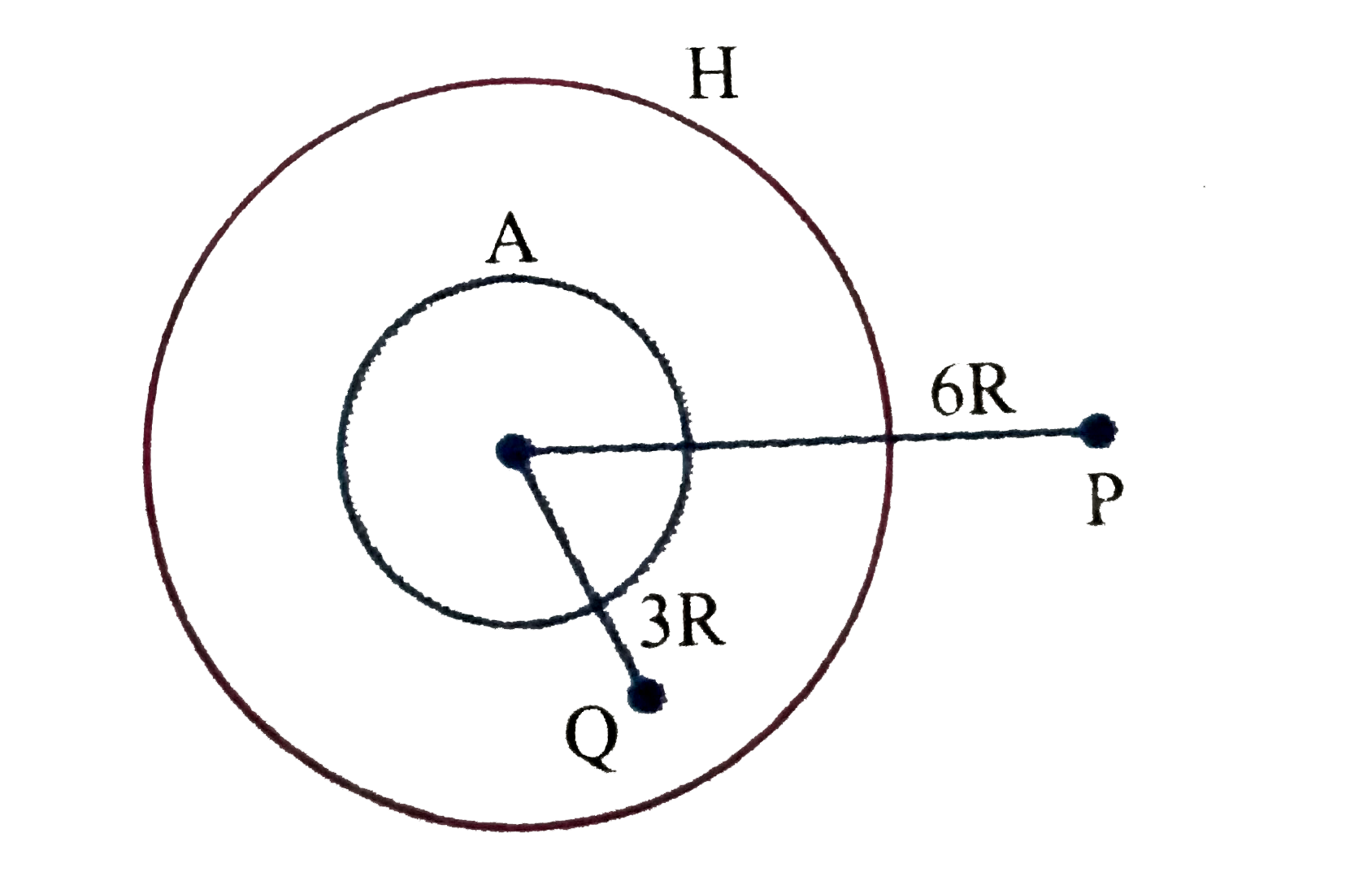
Consider two cases, first one in which `A` is a perfect black body and the second in which A is a non-black In both the cases temperature of boby `A` is same equal to `300K` and `H` is at temperature `600K` For `H t = and a ne 1` For this situation mark out the correct statements (s) .
View SolutionConsider a spherical body `A` of radius `R` which is placed concentrically in a hollow enclosure `H` of radius `4R` as shown in the The temperature of the body `A` and `H` are `T_(A)` and `T_(H)` respectively Emissivity transmittivity and reflactivity of two bodies `A` and `H` are `(e_(a),e_(H)),?(t_(A),t_(H)),` and `(r_(A),r_(H))` respectively (Assume no absorption of the thermal energy by the space in between the body and enclosure as well as outside the enclousre and all radiations to be emitted and absorbed normal to the surface `[Tske sigma xx 4pi r^(2) xx 300^(4) = betaJ//s]`
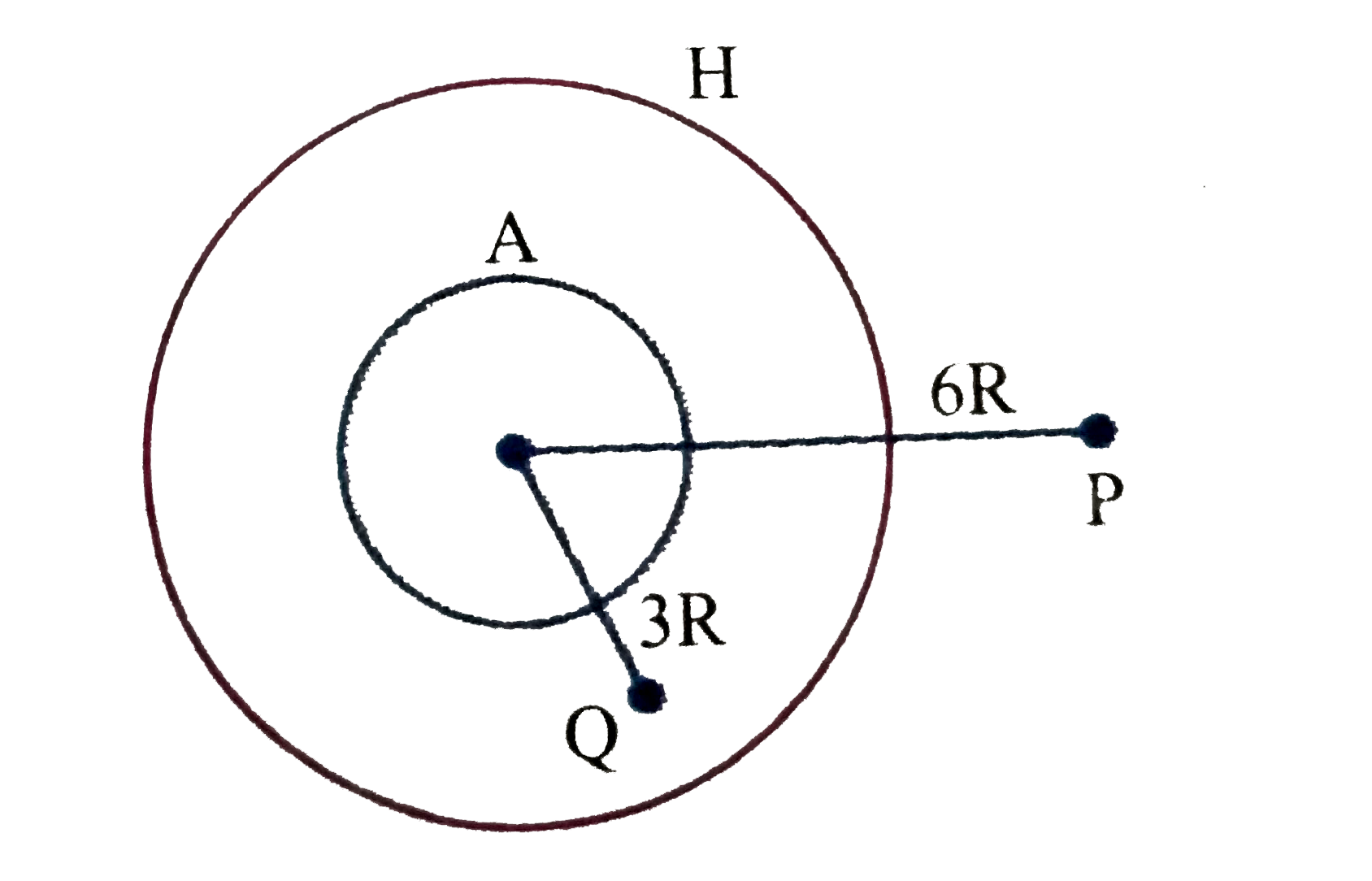
In the previous question if the enclosure is considered as perfect black body and is maintaind at same temperature as that of temperature of body A then in the two cases .
View SolutionA highly conducting solid sphere of radius `R` density `rho` and specific heat s is kept in an evacuted chamber. A parallel beam of thermal radiation of instensity I is incident on its surfcae Consider the sphere to be a perfectly black body and its temperature at certain instant considered at `t =0` is `T_(0)` [Take Stefan's constant as `sigma`] Answer the following questions based on above information
The equation which gives the temperature `T` of the sphere as a function of time is .
View SolutionA highly conducting solid sphere of radius `R` density `rho` and specific heat s is kept in an evacuted chamber. A parallel beam of thermal radiation of instensity I is incident on its surfcae Consider the sphere to be a perfectly black body and its temperature at certain instant considered at `t =0` is `T_(0)` [Take Stefan's constant as `sigma`] Answer the following questions based on above information
The maximum attainable temperature of the sphere is .
View SolutionA few rods of materials `X` and `Y` are connected as shown in The cross-sectional areas of all the rods are same if the end A is maintaind at `80^(@)C` and the end `F` is maintained at `10^(2)C` If the temperature of junctions `B` and `E` in steady state are `(39.48^(@)C)/(n_(1)` and `(60.52^(@)C)/(n_(2)` Find `n_(1)` and `n_(2)` Given thermal conductivity of material `X` double that of `Y`
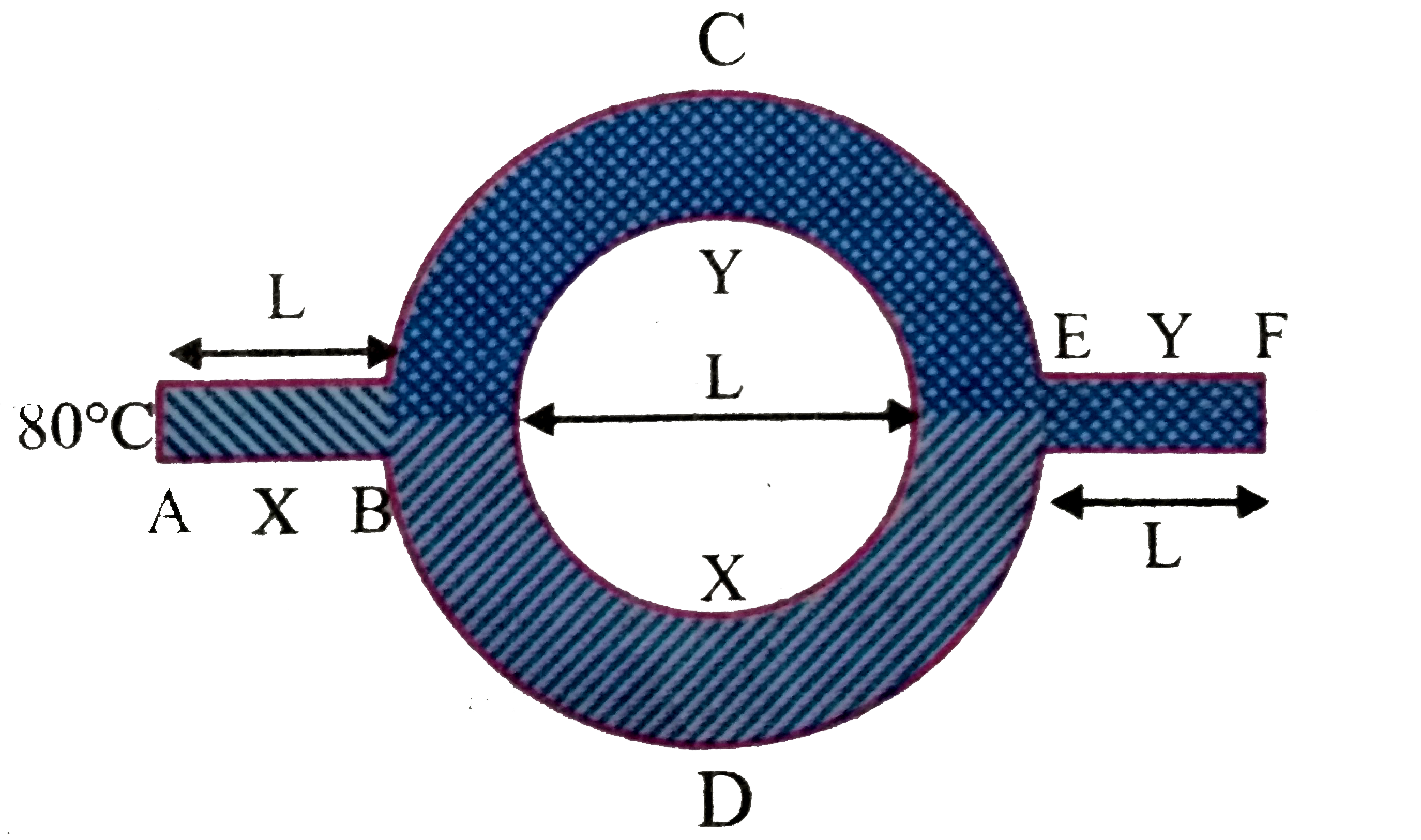 .
.
View SolutionA hot body placed in air is cooled down according to newton's law of cooling the rate of decrease of temperature being k times the temperature difference from the surrounnding Starting from `t =0` The time in which the body will lose half of the maximum heat is `(xLn2)/(2k)` Find the value of x .
View SolutionOne end of a uniform rod of length `1m` is placed in boilling water while its other end is placed in boiling water while its other end is placed in melting ice A point `P` on the rod is maintained at a constant temperature of `800^(@)C` mass of stam produced per second is equal to the mass of ice melted per second. is equal to mass of ice melted per second If specific latent heat of steam is 7 times the specific latent heat of ice, then the distance of `P` from the steam chamber is `n//18` m Find the value of n ? .
View SolutionTwo identical rods are connected between two containers. One of them is at `100^(@)C` containing water and another is at `0^(@)C` containing ice. If rods are connected in parallel then the rate of melting of ice is `q_(1)g//s` . If they are connected in series then teh rate is `q_(2)g//s` . The ratio `q_(2)//q_(1)` is
View SolutionA metal rod AB of length 10x has its one end A in ice at `0^@C`, and the other end B in water at `100^@C`. If a point P one the rod is maintained at `400^@C`, then it is found that equal amounts of water and ice evaporate and melt per unit time. The latent heat of evaporation of water is `540cal//g` and latent heat of melting of ice is `80cal//g`. If the point P is at a distance of `lambdax` from the ice end A, find the value `lambda`. [Neglect any heat loss to the surrounding.]
View SolutionA metal is heated in a furnace where a sensor is kept above the metal surface to read the power radiated (P) by the metal. The sensor has scale that displays `log_2,(P//P_0)`, where `P_0` is constant. When the metal surface is at a temperature of `487^@C`, the sensor shows a value 1. Assume that the emissivity of the metallic surface remains constant. What is the value displayed by the sensor when the temperature of the metal surface is raised to `2767^@C`?
View SolutionThe distance of the Earth from the Sun is 4 times that of the planet Mercury from the Sun The temperature of the Earth in radiative equilibrium with the Sun is `290K` The radiative euilibrium temperature of the Mercury is `5.80 xx 10^(n)` Find the value of n Assume all three bodies to be black body .
View SolutionA metal block is placed in a room which is at `10^(@)C` for long time. Now it is heated by an electric heater of power `500W` till its temperature becomes `50^(@)C` Its initial rate of rise of temperature is `2.5^(@)C//sec` The heater is switched off and now a heater of `100W` is required to maintain the temperature of the block at `50^(@)C` The heat radiated per second when the block was `30^(@)C` is given as `alpha` watt. Find the value of `((alpha)/(10))` (Assume Newton's law of cooling to be valid .
View Solution
SINGLE ANSWER QUESTIONS questions and complete solutions for chapter TRANSMISSION OF HEAT of NARAYANA PHYSICS (HINGLISH) of Class 11